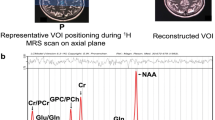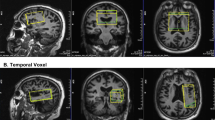Abstract
Persons with Alzheimer’s disease (AD) demonstrate frank impairments in the performance of everyday functional abilities. However, the neuroanatomic and neuro-metabolic correlates of these functional deficits in mild AD are largely unknown. Using 3-Tesla proton magnetic resonance spectroscopy (1H-MRS) of the posterior cingulate gyrus in 14 patients with mild AD and 14 healthy adult controls, we sought to determine the brain metabolic correlates of financial impairments in mild AD. Both N-acetylaspartate (NAA) and choline-containing compounds (Cho) were found to be abnormal in mild AD. In AD patients, NAA showed a positive correlation with financial abilities, while Cho showed a possible negative correlation with financial abilities. These findings suggest that metabolic abnormalities of posterior cortical paralimbic regions may reflect the underlying neuropathological processes that are instrumental in the degradation of financial abilities in mild AD. Proton MRS could offer a means to track brain changes associated with functional change in mild AD.



Similar content being viewed by others
References
Antuono, P. G., Jones, J. L., Wang, Y., & Li, S. J. (2001). Decreased glutamate + glutamine in Alzheimer’s disease detected in vivo with 1H-MRS at 0.5 T. Neurology, 56(6), 737–742.
Block, W., Jessen, F., Traber, F., Flacke, S., Manka, C., Lamerichs, R., et al. (2002). Regional N-acetylaspartate reduction in the hippocampus detected with fast proton magnetic resonance spectroscopic imaging in patients with Alzheimer disease. Archives of Neurology, 59(5), 828–834.
Cavassila, S., Deval, S., Huegen, C., van Ormondt, D., & Graveron-Demilly, D. (2001). Cramer-Rao bounds: An evaluation tool for quantitation. NMR in Biomedicine, 14(4), 278–283.
Chantal, S., Labelle, M., Bouchard, R. W., Braun, C. M., & Boulanger, Y. (2002). Correlation of regional proton magnetic resonance spectroscopic metabolic changes with cognitive deficits in mild Alzheimer disease. Archives of Neurology, 59(6), 955–962.
Dixon, R. M., Bradley, K. M., Budge, M. M., Styles, P., & Smith, A. D. (2002). Longitudinal quantitative proton magnetic resonance spectroscopy of the hippocampus in Alzheimer's disease. Brain, 125(Pt 10), 2332–2341.
Earnst, K., Wadley, V., Aldridge, T., Steenwyk, A., Hammond, A., Harrell, L., et al. (2001). Loss of financial capacity in Alzheimer’s disease: The role of working memory. Aging, Neuropsychology, and Cognition, 8, 109–119.
Firbank, M. J., Harrison, R. M., & O’Brien, J. T. (2002). A comprehensive review of proton magnetic resonance spectroscopy studies in dementia and Parkinson’s disease. Dementia and Geriatric Cognitive Disorders, 14(2), 64–76.
Folstein, M., Folstein, S., & McHugh, P. (1975). Mini-Mental State: A practical guide for grading the cognitive state of the patient for the physician. Journal of Psychiatry Research, 12, 189–198.
Griffith, H. R., Belue, K., Sicola, A., Krzywanski, S., Zamrini, E., Harrell, L., et al. (2003). Impaired financial abilities in mild cognitive impairment: A direct assessment approach. Neurology, 60(3), 449–457.
Griffith, H. R., den Hollander, J. A., Okonkwo, O., Evanochko, W. T., Harrell, L. E., Zamrini, E. Y., et al. (2007a). Executive function is associated with brain proton magnetic resonance spectroscopy in amnestic mild cognitive impairment. Journal of Clinical and Experimental Neuropsychology DOI 10.1080/13803390600826595
Griffith, H. R., den Hollander, J. A., Stewart, C. C., Evanochko, W. T., Buchthal, S. D., Harrell, L. E., et al. (2007b). Elevated brain scyllo-inositol concentrations in patients with Alzheimer’s disease. NMR in Biomedicine DOI 10.1002/nbm.1132
Hattori, N., Abe, K., Sakoda, S., & Sawada, T. (2002). Proton MR spectroscopic study at 3 Tesla on glutamate/glutamine in Alzheimer’s disease. NeuroReport, 13(1), 183–186.
Jessen, F., Block, W., Traber, F., Keller, E., Flacke, S., Lamerichs, R., et al. (2001). Decrease of N-acetylaspartate in the MTL correlates with cognitive decline of AD patients. Neurology, 57(5), 930–932.
Jones, R. S., & Waldman, A. D. (2004). 1H-MRS evaluation of metabolism in Alzheimer’s disease and vascular dementia. Neurological Research, 26(5), 488–495.
Jurica, P. J., Leitten, C. L., & Mattis, S. (2001). Dementia Rating Scale-2: Professional manual. Lutz, FL: Psychological Assessment Resources.
Kantarci, K., Jack, C. R., Jr., Xu, Y. C., Campeau, N. G., O’Brien, P. C., Smith, G. E., et al. (2000). Regional metabolic patterns in mild cognitive impairment and Alzheimer’s disease: A 1H MRS study. Neurology, 55(2), 210–217.
Kantarci, K., Smith, G. E., Ivnik, R. J., Petersen, R. C., Boeve, B. F., Knopman, D. S., et al. (2002). 1H magnetic resonance spectroscopy, cognitive function, and apolipoprotein E genotype in normal aging, mild cognitive impairment and Alzheimer’s disease. Journal of the International Neuropsychological Society, 8(7), 934–942.
Lamb, H. J., Doornbos, J., den Hollander, J. A., Luyten, P. R., Beyerbacht, H. P., van der Wall, E. E., et al. (1996). Reproducibility of human cardiac 31P-NMR spectroscopy. NMR in Biomedicine, 9(5), 217–227.
Marson, D., Sawrie, S., Snyder, S., McInturff, B., Stalvey, T., Boothe, A., et al. (2000). Assessing financial capacity in patients with Alzheimer’s disease: A conceptual model and prototype instrument. Archives of Neurology, 57, 877–884.
McDowell, I. (2001). Alzheimer’s disease: Insights from epidemiology. Aging (Milano), 13(3), 143–162.
McKhann, G., Drachman, D., Folstein, M., Katzman, R., Price, D., & Stadlan, E. (1984). Clinical diagnosis of Alzheimer’s disease: Report of the NINCDS-ADRDA work group under the auspices of the Department of Health and Human Services Task Force on Alzheimer’s disease. Neurology, 34, 939–944.
Morris, J. C. (1993). The Clinical Dementia Rating (CDR): Current version and scoring rules. Neurology, 43(11), 2412–2414.
Okonkwo, O. C., Wadley, V. G., Griffith, H. R., Ball, K., & Marson, D. C. (2006). Cognitive correlates of financial abilities in mild cognitive impairment. Journal of the American Geriatrics Society, 54(11), 1745–1750.
Ouchi, Y., Yoshikawa, E., Futatsubashi, M., Okada, H., Torizuka, T., & Kaneko, M. (2004). Activation in the premotor cortex during mental calculation in patients with Alzheimer’s disease: Relevance of reduction in posterior cingulate metabolism. NeuroImage, 22(1), 155–163.
Parnetti, L., Tarducci, R., Presciutti, O., Lowenthal, D. T., Pippi, M., Palumbo, B., et al. (1997). Proton magnetic resonance spectroscopy can differentiate Alzheimer’s disease from normal aging. Mechanism of Ageing and Development, 97(1), 9–14.
Petersen, R. C., & Morris, J. C. (2005). Mild cognitive impairment as a clinical entity and treatment target. Archives of Neurology, 62(7), 1160–1163 (discussion 1167).
Pfefferbaum, A., Adalsteinsson, E., Spielman, D., Sullivan, E. V., & Lim, K. O. (1999). In vivo brain concentrations of N-acetyl compounds, creatine, and choline in Alzheimer disease. Archives of General Psychiatry, 56(2), 185–192.
Ross, A. J., & Sachdev, P. S. (2004). Magnetic resonance spectroscopy in cognitive research. Brain Research Brain Research Reviews, 44(2–3), 83–102.
Valenzuela, M. J., & Sachdev, P. (2001). Magnetic resonance spectroscopy in AD. Neurology, 56(5), 592–598.
van Dijk, J. E., Mehlkopf, A. F., van Ormondt, D., & Bovee, W. M. (1992). Determination of concentrations by time domain fitting of proton NMR echo signals using prior knowledge. Magnetic Resonance in Medicine, 27(1), 76–96.
Wadley, V. G., Harrell, L. E., & Marson, D. C. (2003). Self- and informant report of financial abilities in patients with Alzheimer’s disease: Reliable and valid? Journal of the American Geriatrics Society, 51(11), 1621–1626.
Waldman, A. D., & Rai, G. S. (2003). The relationship between cognitive impairment and in vivo metabolite ratios in patients with clinical Alzheimer’s disease and vascular dementia: A proton magnetic resonance spectroscopy study. Neuroradiology, 45(8), 507–512.
Watanabe, T., Akiguchi, I., Yagi, H., Onishi, K., Kawasaki, T., Shiino, A., et al. (2002). Proton magnetic resonance spectroscopy and white matter hyperintensities on magnetic resonance imaging in patients with Alzheimer’s disease. Annals of the New York Academy of Sciences, 977, 423–429.
Acknowledgements
This research was supported by grants from the National Institute on Aging (Alzheimer’s Disease Research Center; 1P50 AG16582-01: Harrell, PI), (1R01 AG021927-01: Marson, PI) and grants from Alzheimer’s of Central Alabama.
Author information
Authors and Affiliations
Corresponding author
Rights and permissions
About this article
Cite this article
Griffith, H.R., Okonkwo, O.C., den Hollander, J.A. et al. Brain Proton MRS is Correlated with Financial Abilities in Patients with Alzheimer’s Disease. Brain Imaging and Behavior 1, 23–29 (2007). https://doi.org/10.1007/s11682-007-9002-3
Published:
Issue Date:
DOI: https://doi.org/10.1007/s11682-007-9002-3




